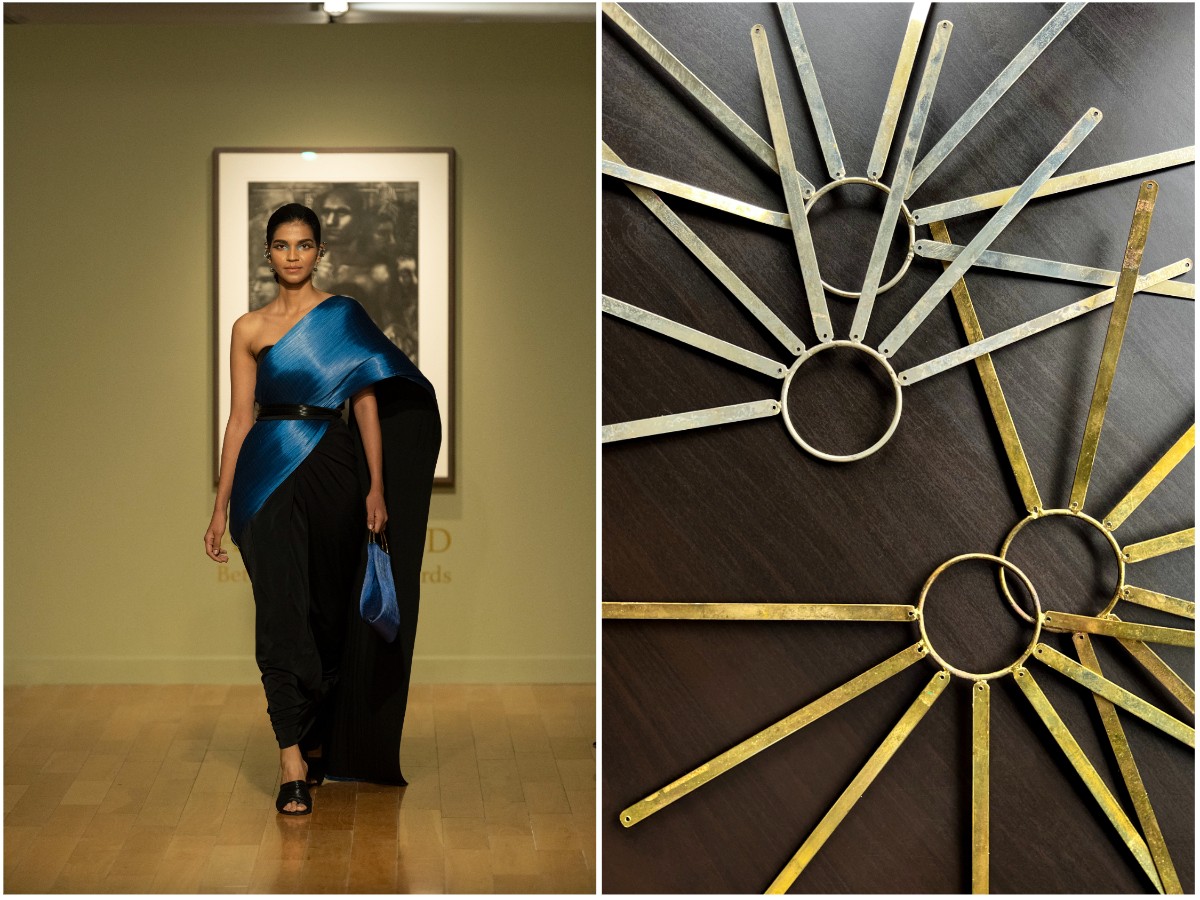Rimzim Dadu has completed 15 years of her label, transforming factory scrapware into elegant dresses that has Delhi’s fashionistas queuing up for more.
The beauty of this journey in a city like Delhi is that most of her materials are not sourced from high-end fabric sellers, but scrap markets and hardware stores.
One will never see shining sequins, ek tar, dabka even the most loved zardosi, but offbeat steel wires, sourced from karkhanas (workshops), acrylic, silicon and most recently paper converted into textiles.
Also read: ‘I do not’, says the bride and breaks free from tradition
“When I began my trek in fashion at the age of 21, my audience found my clothes to be too structured, as I was not catering to commercial taste. There was no instant acceptability,” says the Pearl Academy graduate.
Innovative idea
Once she decided on her offbeat path, she had to convince her team that steel can be beaten down to a malleable fabric. Subsequently, her iconic steel wire sari (each wire is hair-thin measuring 0.45 mm), was launched six years ago and is now a signature piece loved by loyal fans.
The key is to offer longevity in each ensemble and not succumb to the pressure of trends, she says.
“We have many customers, who ask us when they visit our showroom, if the steel sari is comfortable to wear, can one travel wearing it? I feel it has a sense of deception, a mystery surrounding it. In reality, the sari moulds around your body and our store managers educate you on how to wear it,” says Rimzim.
Similar to the Japanese great Issey Miyake, she also fused paper with fabric to re-engineer a new textile, just like her experiments with silicon, to mix it with the legendary Jamdani and create a weave which took two years to craft on a hand-operated loom.
“The audience is aware that they want innovation. I never thought brides would like to wear a stainless steel sari on their big day. There is now greater acceptance of newer things,” she explains.
Delhi loves to shine even during the day, as the customer here is on a bling train, but Rimzim believes, taking traditional things and reimagining them is what makes the brand truly different.
“I took zari yarn and made it grunge by shredding it; sequins are loved by Delhiites, I burnt them individually with a candle flame to make ingenious patterns and then placed them on fabric,” she describes.
One can call it a rebellious streak, or the will to take the road less travelled. Guided by her garment exporter father, Rimzim understood that taking on new materials means having no rule book to follow, so she chartered her own path.
“Sometimes it takes months to make a sari. We also try to update it by relooking at functionality, making design solution-based for the modern working woman,” she adds.
With research and development at the core of the label, Rimzim is now looking at making material out of bamboo. When no one was talking about sustainability 15 years ago, she knew the path she wanted to follow. Thus, each piece has a shelf life, no wastage, abandoning the concept of “outdated”.
Repurposing drive
Designer Amit Aggarwal has gained not just the respect of his peers, but also the tag of “innovator” for his unusual choice of embroidery and materials. This ranges from discarded bindi sheets, polymers, recycled rubber cords, nylon strands and scraps of discarded plastic from polythene bags. Add to this mix wearability and comfort, for the garments he offers are lightweight.
There is no ironing required for Amit’s ensembles as they don’t crush, and he has got rid of can-cans.
To make it foolproof, each technique is first exposed to various elements to see how the newly-created fabrics react. Pliability, malleability and fading – each aspect is explored.
For example when he used recycled polythene bags, the challenge was how to increase production.
The scenario has really changed for the better now, he says. The young woman wants to know how her garment was made, what materials were used and nothing in the Amit Aggarwal lab is cut from ready-made fabric or computer generated.
“We sourced discarded Patola and Banarasi saris from the Rabari community, which for years has been trading steel utensils in exchange for old clothes. We combined different pieces and made an entirely new fabric, the learning was how to weave in the bad parts with the good ones,” says Amit.
When he begins a line, the key is to look at concept builders and the other is ensure maximum usage. The fabric made out of polymers was blended with cotton, inspired by the ikkat weave, done on handloom, giving the most unexpected results. Nothing was predictable in this fabric, he layered it with yarn to make it malleable, this also guaranteed no skin abrasions.
“When we deal with unconventional materials, we have to train artisans, who are not master craftsmen, but people who are skilled but unafraid to make an error, as we don’t work with a set template,” he adds.
Imagine buying a Rs 75,000 to Rs 1,00,00 Amit Aggarwal gown made of recycled plastic. You would never imagine a Delhi customer adoring it but they do. “Salma came to us eight years ago looking for a job, she learnt everything here and our factory is run by women artisans,” he adds.
Interestingly, Amit has also worked with bindi sheets left behind after the bindis are used, these were overlaid on cotton, creating a jaali effect, almost like felting with a superfast glue. Amit made contemporary parkas and skirts, for his erstwhile label Am-It, which he hopes to revive soon.
“I think I have come a long way from the audience admiring my creations to finally wearing them, as their doubts about comfort are slowly fading,” he concludes.
Follow us on:
Instagram: instagram.com/thepatriot_in/
Twitter: twitter.com/Patriot_Delhi
Facebook: facebook.com/Thepatriotnewsindia





